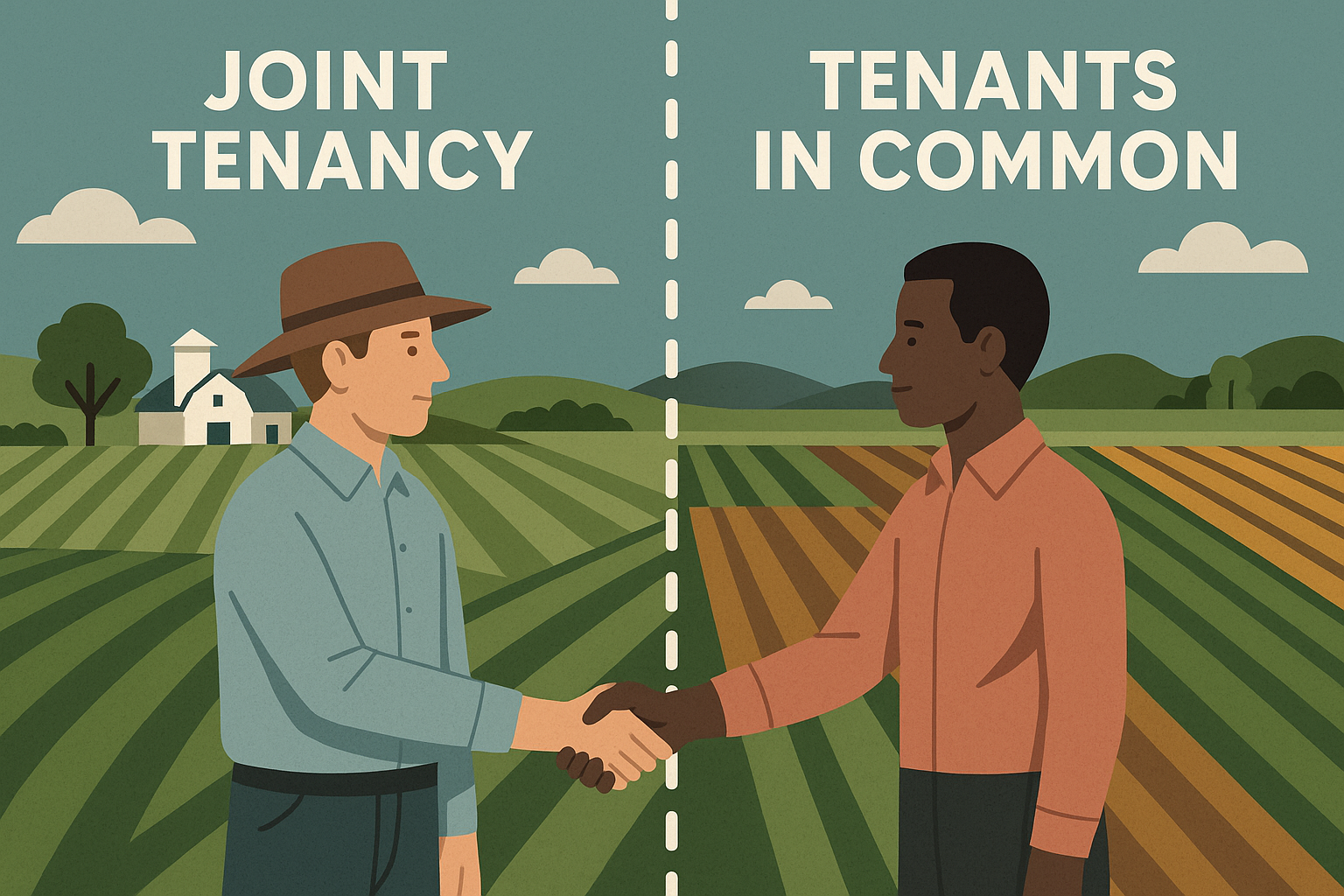Introduction
Buying farmland with partners can be rewarding, but the ownership structure you choose matters. Joint Tenancy or Tenants in Common shapes inheritance, financing, and liability.
Farmland buyers often overlook legal details and end up with title issues or surprise tax bills. Thinking about buying land with someone else? This guide shows you how shared ownership works and what lenders check before approving your loan.
1. Ownership Basics
What is Joint Tenancy?
Each person owns an equal share of the land. It’s also called Joint Tenancy with Right of Survivorship. If one owner dies, their share transfers to the surviving owners.
What is Tenants in Common (TIC)?
Each person can own a different share—say 70% and 30%. When one owner dies, their share passes to their heirs through a will or probate, not to the other owners.
| Feature | Joint Tenancy | Tenants in Common |
|---|---|---|
| Shares | Equal for all owners | Flexible (equal or unequal) |
| Survivorship | Yes (automatic) | No (goes to heirs) |
| Probate Needed | No | Yes (unless other estate planning) |
| Number of Owners | Varies by state | Unlimited |
| Common Use | Family farms | Partnerships and investors |
Source: USDA Farm Service Agency Title Handbook, 2025 Update
2. Why Farmland Investors Care
Equity Release & Flexibility
Joint Tenancy works well for family-run farms where heirs plan to keep operating. Tenants in Common lets owners sell or transfer their share at any time.
Financing Impacts
Joint Tenancy usually requires one promissory note signed by all owners. If one defaults, everyone is liable. With TIC, lenders may issue separate loans to each owner or one shared loan that holds all parties responsible.
Tip: Many private lenders prefer TIC because they can review each buyer’s finances separately.
3. Tax Implications for Agricultural Land
| Aspect | Joint Tenancy | Tenants in Common |
|---|---|---|
| Step-Up in Basis | Only for deceased owner’s share | For each owner’s share |
| Estate Tax Planning | Limited flexibility | High flexibility (can gift fractions) |
| 1031 Exchange | Entire property must exchange | Individual shares can exchange |
Tenants in Common allows each owner to use a 1031 exchange to defer taxes on their share, making it ideal for land flippers or generational planning.
Joint Tenancy avoids probate but can increase the surviving owner’s estate value and lead to higher taxes. For large holdings, planners often recommend TIC.
IRS Publication 551 – Basis of Assets
4. Legal & Liability Considerations
Liens & Judgments: In Joint Tenancy, a lien against one owner clouds the entire title. In TIC, creditors can attach only the debtor’s share.
Owners should draft a co-ownership agreement to cover management roles, dispute resolution, and share transfers.
Pro Tip: Even with Joint Tenancy, a co-ownership agreement helps outline upkeep costs, income splits, and exit strategies.
5. How Lenders Check Each Structure
| Metric | Joint Tenancy | TIC |
|---|---|---|
| Underwriting Complexity | Low | Medium–High |
| Credit Checks | All equal | Per share |
| Collateral Control | Single title | Fractional title |
| Typical LTV | 55–65% | 50–60% |
6. Choosing the Right Structure
- Family Legacy: Joint Tenancy
- Investor Flexibility: TIC
- Tax Strategy: 1031 exchange? → TIC
- Financing Needs: Simpler loans → Joint Tenancy
- Exit Plan: Flip in 5–10 years → TIC
7. Steps to Set Up Your Ownership Structure
- Consult an ag-savvy attorney
- Draft a co-ownership agreement (mandatory for TIC)
- Secure title insurance with necessary endorsements
- Match loan documents to deed vesting
- Record the deed with your county office
Conclusion
Choosing Joint Tenancy or Tenants in Common affects more than the paperwork. It shapes your loan terms, taxes, and how the land passes on. Make sure you and your partner agree on goals, ownership splits, and lender requirements.
Need custom financing for your farmland partnership? Contact Private Capital Lenders today to structure your deal the right way.



